207. $850
Southern Calendar Clock Co. St. Louis, Mo., “Fashion No. 4”,
ca 1880. Walnut case is 32” high, retains the original finish that has been cleaned of smoke and other pollutants. It has been restored,
in that the dials have been repainted, paper calendar rolls replaced, and probably has replaced finials. The left finial is definitely
a replacement so must assume the other two are as they are glued in place. The walnut finials are exact copies of originals and have
been stained to match the case finish. The running and calendar movements are operating properly, and inside is the original black
and gold label of instructions. The damascened brass pendulum and wood stick are correct. Large brass bell is clean and bright, correct
hands, and it has nice nickeled dial rings. Etched designs on the dial board retains all of the gilt, the tablet is excellent, and
as usual I was disappointed when I looked in the secret compartment. Overall a very good example of this model and as nice as most
No. 4’s we have sold. Ly-Calendar, page 286; also in Ly-Seth Thomas book. $1000-$1500.
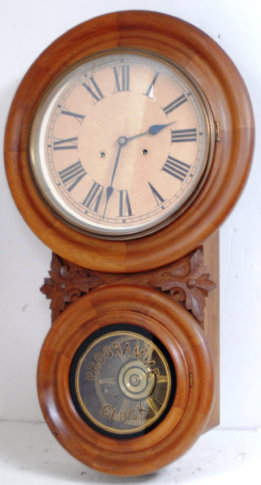
208. $500
Samuel Estell, inventor of the “Estell Program Regulator Clock”, ca 1870. Our research has found a handful of his program clocks but always in very small cases, under 20 inches tall. Most were produced by the “US Clock and Brass Co.”. Our clock has a signed Chauncey Jerome 8-day movement. Jerome was connected to the US Clock and Brass Co. at some time, so was probably connected to Samuel Estell. See articles in the NAWCC Bulletins for more information. Nowhere have I found that they made a clock of this size (31 inches high) or of this type. All I found were small shelf clocks. The labels on the back of this clock indicate it was made by, “Jerome & Company”, for use in schools. It can be programed to ring bells at set to strike at any time, every five or ten minutes, or half hour as may be required. The running movement strikes on a bell each hour. We could find no prior sales of this large school clock but the small shelf clocks were selling from $500 up. $750-$1000.
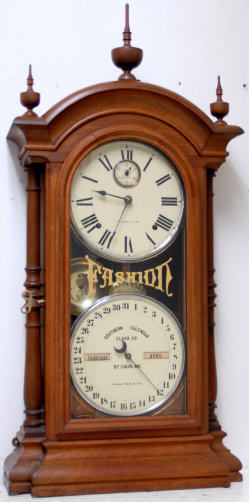

209. $150
“American Clock Co. / Depot, No. 3 / New York, N.Y.” iron front
shelf clock, , ca 1856. They were sales agents for Connecticut clocks make by several clock companies. They were agents for many clock
companies and did not use their own labels until 1856. I can find no information indicating they made clocks. This case is almost
14” high, it has a flat glass in the sash. New paper dial, correct hands, and pendulum bob. Complete paper label inside. Note the
painting of the “Gleaners” at the base. The movement is eight-day, time and strike. $150-$250.
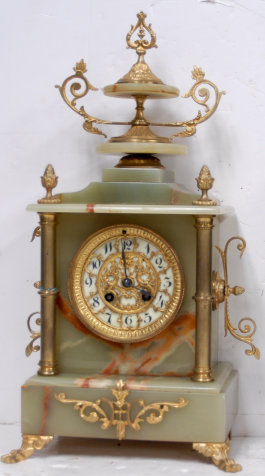
210. $150
French onyx and brass shelf clock, overall in very good original
condition. It is 18” tall, has several cast objects attached to the case body. It has a flat beveled glass, bronze beaded sash, one-piece
porcelain dial overlaid with cast brass decorations leaving room for the numerals to be seen. It has nice and original hands. Neither
the dial or the movement is signed. On the back is a bronze hinged sash with cloth over the backside. Typical French round 8-day movement
with bell strike. This is an extremely nice clock that should fetch considerably more than our minimum. $250-$500.

211. $400
“Wadsworths, Lownsbury and Turners, Litchfield, Conn. pillar and scroll clock, ca 1825-1827. The partnership was formed by at least six persons to make pillar and scroll clocks with distinctive wood movements. It was probably made at Bigelow Bros. Saw Mill, Litchfield, Conn. as Wadsworth had a clock shop near there. See page 300, “The Book of American Clocks” by Brooks Palmer. One collector said this pillar and scroll is noteworthy as it contains a rather rare Leavenworth style movement. He marked this 30-hour wood movement as, “2A13L 42 teeth esc.”. The mahogany veneered case is about 31 inches tall, including the solid brass screw on replacement finials. Typical of this collector’s restored clocks the veneer, label, and dial, are near perfect. He also insisted on those things above all else. The painted glass is a replacement by Tom Moberg. It has a wood door knob that was added many years ago over an old lock that looks to be complete. The escutcheon is also still in place. The old wood dial is very nice as are the hands, pendulum, iron bell, and iron weights that are all of the period and no doubt original to this clock. As is so typical of scrolls, the top is all original but one scroll tip was broken and glued. The skirt and feet are also original to the case. Overall it is beautifully cleaned and polished. A similar clock is in the Museum of Conn. History and shown on page 9 of “American Shelf and Wall Clock” by Robert W. D. Ball. $500-$750.
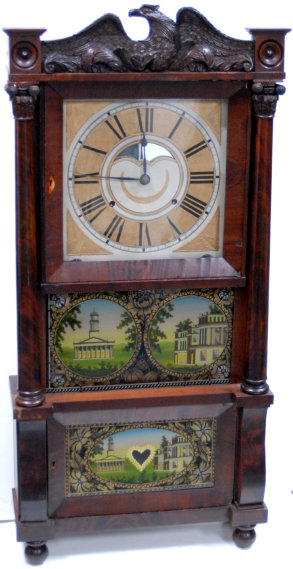
212. $300
“C. & L. C. Ives, / Bristol, Conn.” copied from the near complete paper label. The triple deck case, ca 1832-1835, is mahogany veneered and is 38” high, with a very nice carved eagle splat, complete chimneys and returns, full turned columns in the center, and four ball feet on the bottom. Top door has original door lock, but no key or escutcheon. Bottom door has the lock and the escutcheon. Overall the veneer is pretty good, a chip or two and frayed edges around the doors and base. The top glass is held in place with original putty, but the two lower glasses are replacement paintings by Tom Moberg. The old wood dial is very good and has a replaced mirror. It has an 8-day, unsigned, strap brass movement and strikes on an iron bell. There is a correct pair of old iron weights and an old pendulum bob. The case has some loose parts that need attention – gluing should do the trick. $350-$550.

213. $50
“Davies Patent Lever Clock Manufactured in Plymouth, Con. And
sold by R. Blakeslee, Jr.”, 30-hour OG clock, ca 1848. Researchers reported there was no evidence the 30-hour brass movements were
“lever” although they were advertised as such. The OG mahogany veneered case is nice, very little to criticize. Tablet is a replacement,
dial slightly soiled but no paint loss, coil gong and one of the iron weights are replacements. Hands, pendulum and door latch are
probably original. $50-$100.
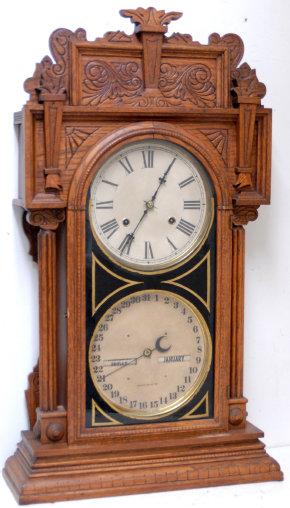
214. $500
Waterbury Clock Company “Calendar No. 43”, ca 1912. The oak case is 28” high, has the original finish, all original wood parts, and appears to have been partially cleaned yet is not smoky. Both dials are paper replacements. Running movement is 8-day with strike and it is running properly and calendar functioning correctly. Glass paint is original, very minor flaking or thin when viewed from the back side. In addition to being a calendar clock, it is a striking model. Two labels on the back, mostly there, old pendulum bob, a winding key. This is a nice example of this model. Ly-Waterbury #238. $650-$900.
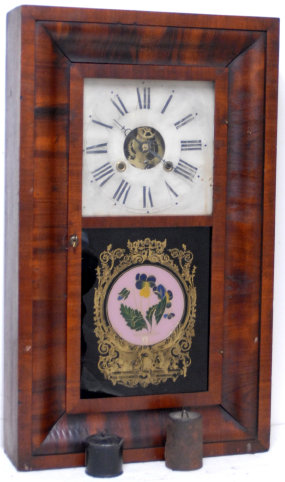
215. $600
Ansonia Clock Co. hanging clock, “Reflector”, ca 1883. This one
is the earlier of two models pictured in the Ansonia catalogs. The Reflector is a super looking clock, but being black with mirrors
on both sides, seems impossible to take a good picture, at least for a non-professional photographer. Some very talented person completely
repainted the 35-inch case black, like it was originally. Only an astute clock collector can tell it does not have the original paint.
The 8-day movement is running and striking on a gong. Four of the five glasses are perfect but the bottom right mirror is cracked.
It has a very nice pendulum and beat scale. I have seen them sell in the gone by days for $1800 with the paint even stripped off,
and have heard of them bring a lot more at east coast auctions. This one is as nice as any we have sold, even considering the repaint.
Ly-Ansonia #574. $750-$1000.

216. $750
“William E. Hadlock & Co., Boston, MA”, high grade spring
driven wall regulator, ca 1874. This is a very rare model clock with some unusual design features. Note the oversized wood bezel that
extends outside the case body. The walnut case is 38 inches tall, has a pegged topo ornament, original painted glass, pendulum and
stick, and an 8-day time only brass movement. It is of the highest quality and powered by a large main spring. The pendulum is mounted
in front of the movement therefore is close to the front of the case and can be more visibly viewed. The dial is near perfect and
I cannot swear it was repainted or original. Hadlock made two very similar style of this clock, this one being slight small of the
two. The larger one has finial type ornaments on the top each side of the removable top piece. We have found only two other examples
of his regulators, both the larger styles. In addition to being a clockmaker-watchmaker, he was probably best known as a chronometer
maker. $1000-$1500.
